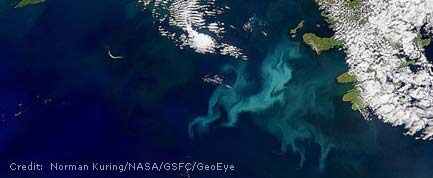Future of the Ocean: Expanding Dead Zones

In recent years, massive fertilizer runoff from big farms has depleted oxygen in parts of the ocean, choking off life in these aptly-named dead zones.
That much is well known and widely studied.
But in the future, pollution won’t be the only thing stripping the oceans of oxygen, as global warming’s effects could leave the seas deprived of oxygen for thousands of years, a new computer model simulation suggests.
The research is not just based on pure prognostication. Already, oxygen levels in the world's seas have been declining for decades as the water has, on average, become warmer.
As carbon dioxide from fossil fuel combustion accumulates in Earth's atmosphere, warming the planet, the oceans warm in response. This warming in turn alters the chemistry of the ocean, specifically, decreasing the waters' ability to hold oxygen. Several studies in recent years have shown this relationship.
But some of the carbon dioxide already in the atmosphere is going to be hanging around for thousands of years, and "no studies have really looked at the effects on the Earth system itself over such long times scales," said the leader of the new study, Gary Shaffer of the Niels Bohr Institute at the University of Copenhagen in Denmark.
Shaffer and his colleagues did just that, using a model to project the changes in dissolved ocean oxygen over the next 100,000 years.
Get the world’s most fascinating discoveries delivered straight to your inbox.
"So we were able to sort of get a complete picture of how the oxygen depletion develops and how it recovers," Shaffer told LiveScience. The results of the study were detailed on Jan. 25 in the online issue of the journal Nature Geoscience.
Anoxic expansion
While some anoxic areas (those with oxygen levels too low to support fish and shellfish) are created by man-made fertilizer runoff from rivers, others exist naturally at intermediate depths in the ocean — these are called oxygen minimum zones. These low-oxygen areas can be found in the eastern Pacific Ocean and the northern Indian Ocean, Shaffer said.
"About 2 percent of the ocean is covered by these zones already at 500 meters [1,600 feet] depth," he said.
As the ocean water warms and becomes less soluble to oxygen, these areas will expand, with the greatest effects off the coasts of Peru, Chile, and California and in the seas on both sides of India, the model projections show.
In fact, a May 2008 study in the journal Science already found that ocean oxygen levels have been decreasing in parts of the open ocean since the 1950s as a result of warming ocean waters.
Ocean oxygen levels globally "have been on the decline for a long time," said Peter Brewer of the Monterey Bay Aquarium Research Institute in Moss Landing, Calif. Brewer was not involved with the study.
It will take some time, a few thousand years, for the full effect of oxygen depletion to be felt. This is because the ocean takes much longer to warm than the air or land.
After the surface waters have become depleted in oxygen, oxygen levels in the deep ocean could also dip if warming slows down the ocean's circulation, as some models predict. Shaffer acknowledges some skepticism on this point, but says that he and his colleagues "wanted to cover all the possibilities which have been brought up before."
The team's work was supported in part by the Danish Natural Science Research Foundation and CONICYT-Chile.
Biological effects
As oxygen levels drop, the ocean waters become unable to support many marine species. Extreme ocean oxygen depletion events are one of the theories proposed to explain some of Earth's mass extinctions, including the largest such event at the end of the Permian 250 million years ago.
As anoxic zones expand, nitrate — a form of nitrogen and an essential nutrient for life — is stripped from the ocean. This shifts the biological production in sunlit ocean surface waters. Fish and shellfish that would normally populate an area give way to plankton species, which don't need nitrate because they can draw dissolved nitrogen directly from the water. This is the same situation that creates the familiar algae blooms seen in the Gulf of Mexico and Baltic Sea dead zones, though these are a result of fertilizer runoff.
Such a shift can lead to large, unpredictable changes in the food chains of these ecosystems, threatening fisheries that we humans depend upon for food.
"[Ocean oxygen depletion is] a very, very important possible consequence of global warming, and one should be aware of all possible consequences of global warming," Shaffer said.
Brewer agrees, noting that ocean effects of global warming have been less well-constrained than effects to the land and atmosphere in reports such as those from the Intergovernmental Panel on Climate Change (IPCC). Shaffer and his team's work adds to a growing body of research shedding light on oxygen depletion in the ocean, Brewer told LiveScience.
But unlike the fertilizer-fueled dead zones, which could be recovered relatively quickly once the pollution is stopped, anoxic zones created by global warming will take far longer to bounce back. What was thousands of years in the making will take thousands of years to undo.
"Once you get things going, they're going to be around for thousands of years," Shaffer said.
The only way to stop the problem is to reduce fossil fuel emissions over the next few generations, Shaffer said.
"I used to like to say that what we do in the next few generations affects the next few thousand generations," he said.
But even if we do curtail emissions, there is still some warming already set by current emissions that would cause anoxia, but it would last for only a few hundred years, instead of a few thousand, Shaffer said.
- Video – Who Pays Most for Earth's Ills
- Video – Changing Earth: How Dead Zones Form
- Climate News and Information

Andrea Thompson is an associate editor at Scientific American, where she covers sustainability, energy and the environment. Prior to that, she was a senior writer covering climate science at Climate Central and a reporter and editor at Live Science, where she primarily covered Earth science and the environment. She holds a graduate degree in science health and environmental reporting from New York University, as well as a bachelor of science and and masters of science in atmospheric chemistry from the Georgia Institute of Technology.
